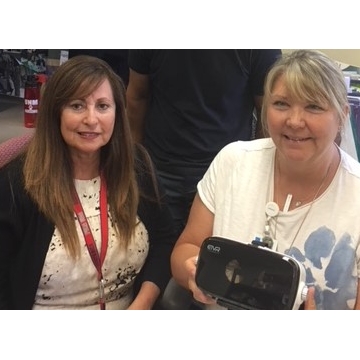
UNM College of Nursing Students Gain Valuable Skills Through Cutting-Edge Clinical Evaluation Program
Virtual OSCE Program Is Success
It's one thing to have someone tell you how to handle a situation. It's another thing to learn about it first-hand. Thanks to new technology, UNM nursing students now have more chances to learn from life-like simulations.
Objective Structured Clinical Evaluations - OSCEs - are a teaching tool that have been used for decades to provide students with real-life scenarios that build the clinical competencies they will need throughout their careers.
Nursing students normally participate in them during their final year of training - which led to something of a hiccup for those enrolled at the UNM College of Nursing.
"We have a Health Resources & Services Administration Grant that requires our students to travel out of town for three months instead of two during the final year," says Kristen Ostrem-Niemcewicz, DNP, RN, CNM, FNP-BC, an assistant professor, program director and nurse-midwifery concentration coordinator in the College of Nursing.
"For my class, I had to come up with something that would work and get the same clinical experience outcome for students who were in remote locations," Ostrem-Niemcewicz says. "That is where the whole idea of a virtual OSCE began."
OSCEs start with a simulated scenario involving a standardized patient. As the case plays out, instructors evaluate the student's clinical skills and diagnostic reasoning, which includes assessment and management of the patient's condition.
Ostrem-Niemcewicz began to wonder if an OSCE could be built that would allow her students to use virtual technology to interact with patients and then be able to review their behaviors and performances. Video examinations are likely to play an important role in a nurse's future, she reasoned. Why not join it up with emerging information technology?
Enter Dominquez Benavidez of the College of Nursing's IT program, who pointed out that 360 video production is an emerging technology with the potential to better immerse the student training experience.
OSCEs become more complex as a student's training continues, so it would seem that a learning model that mimics a computer game would be a no-brainer, Benavidez says.
"There have been a number of advancements in 360-degree technology, and it is definitely an emerging technology," he says. "So, we thought maybe we should start moving this way in terms of future-proofing it, getting a bit more tech-savvy."
"We coordinated and wrote the grant together," Ostrem-Niemcewicz recalls. The team started work in the summer of 2017 on securing a grant for creating a programmable virtual OSCE for students in their final year. The project went live on February 8, 2018.
The feedback was very positive, and the decision was made to make it a permanent part of the program, says Therese Hidalgo, DNP, RN, CFNP, a clinician educator and College of Nursing assistant professor who is the OSCE coordinator.
"As more and more health insurance providers offer this type of digital appointment for patients, it is crucial that students learn how to interact with patients in this way," Hidalgo says.
"These types of exams are going to be part of our nursing student's practice in the future, so having been through these exercises actually gives our students a valuable skill," Ostrem-Niemcewicz says. "It has been satisfying to realize that something we began as an experiment to help students stay current actually has placed our students on the cutting edge of technology."